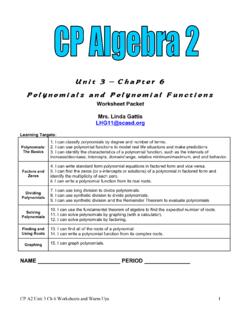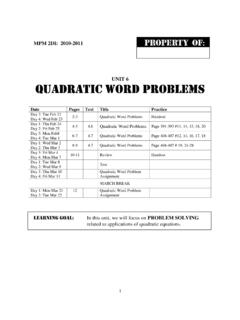Transcription of SW Science 10 Unit 6 Relative Dating Worksheet
1 SW Science 10 unit 6 Relative Dating Worksheet Name: _____ Student #: _____. Geologic Time Relative Dating The Law of Superposition In any undisturbed sequence of strata, the oldest layer is at the bottom of the sequence, and the youngest layer is at the top of the sequence. The Cross-Cutting Law Any feature that cuts across a body of sediment or rock is younger than the body of sediment or rock that it cuts across. NOTE: A fracture is a crack in rock. A fault is a fracture along which movement has occurred. The Law of Inclusions If one rock body contains fragments of another rock body it must be younger than the fragments of rock it contains.
2 OR The inclusions are older than the rocks which contain them. Inclusions Inclusions of B are older than C. Page 2. Telling Relative Time Use the laws of superposition, inclusions and cross-cutting relationships to determine the Relative ages of the following cross-sections. Determine the OLDEST bed FIRST. B. A. C. 1 Cross-cutting, Inclusions A. D. C. B. 2. E. Baked Contacts, Superposition A. B. D. E. 3. C. Cross-cutting, Superposition SW SC10. unit 6 Earth Forces Relative Dating WS. Page 3. BH. X. H. G. G F. F. E E. C D. M. B A. D. 4 A. M. C. B. E. I. D. H. B. F. 5. A. C.
3 G. Outline the sequence of events in the cross sections below by numbering each rock unit or event in the order in which it occurred or was deposited. Youngest A. _____. D. _____. _____. E. _____. B. 6 Oldest C. _____. E. SW SC10. unit 6 Earth Forces Relative Dating WS. Page 4. C. Refer to the cross-section on the left. For each of the following pairs of rock layers, identify the Relative Dating law that would be used to determine which bed was older and which was younger. Circle the letter of the OLDER bed. 7. A&B _____. A Crosscutting C&D _____. D Crosscutting D&E D Superposition _____ J&K _____.
4 J Superposition F. B. K. H. A. J. D. M. H. C. 8 L. G. E. Refer to the cross-section above. for each of the following pairs of rock layers identify the Relative Dating law that you used to determine which bed was older and which was younger. Circle the letter of the YOUNGER bed. M&A _____. A Crosscutting J&N _____. N Superposition H&C _____. H Crosscutting D&M _____. D Superposition SW SC10. unit 6 Earth Forces Relative Dating WS.


